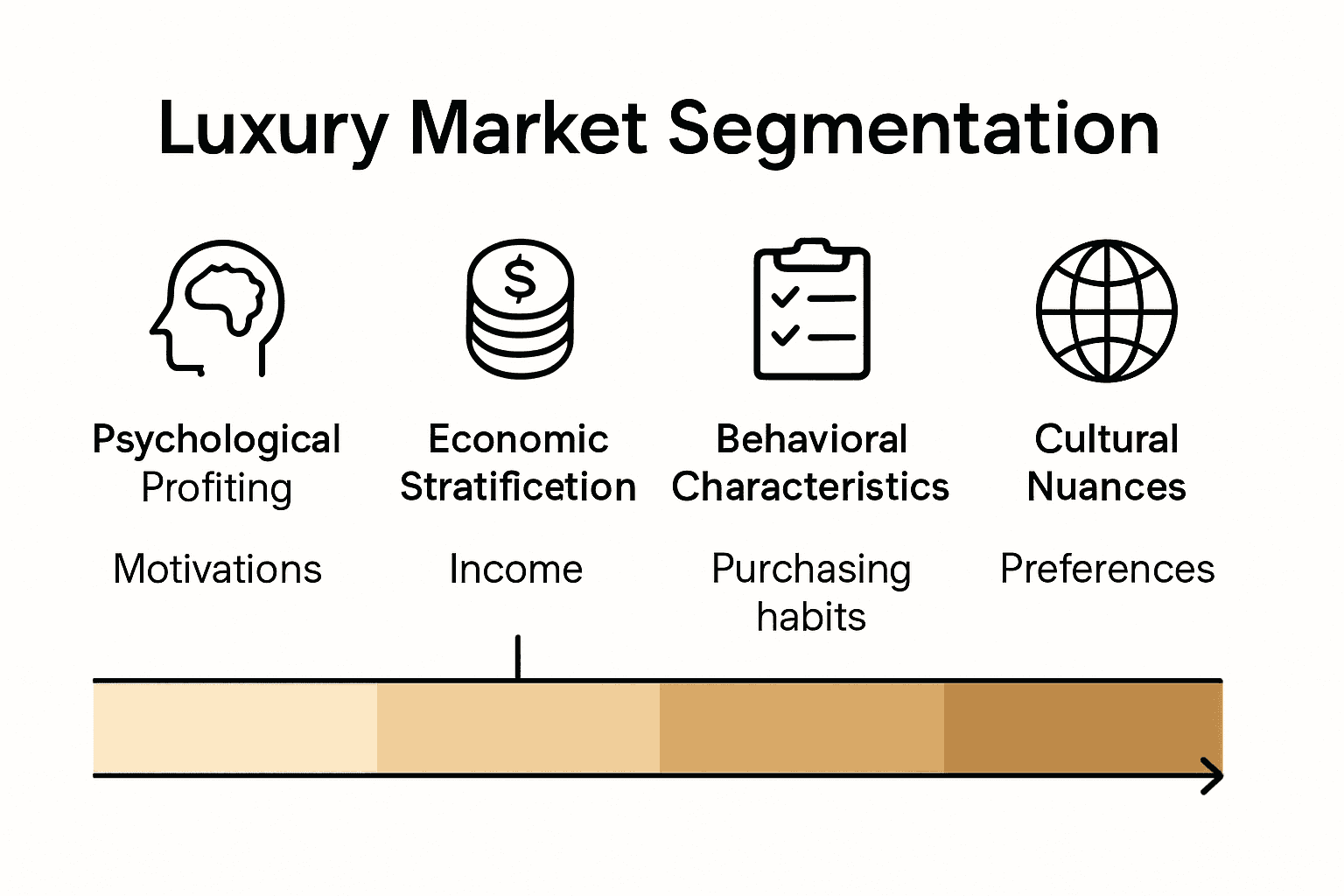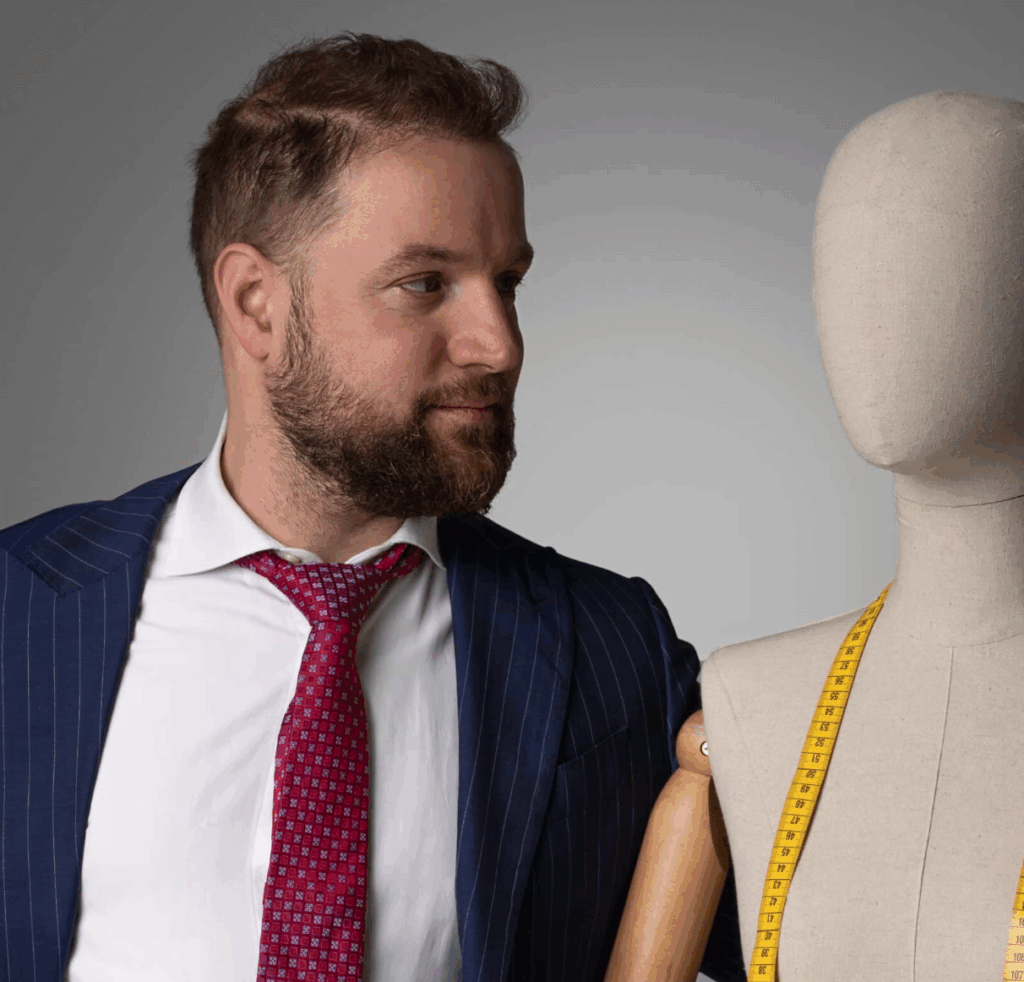Luxury brands know that no two high-end shoppers are the same. In fact, the luxury market is divided into distinct segments like premium, high-end, prêt-à-porter, and haute couture, each shaped by unique values and motivations. Understanding these subtle differences is vital for brands aiming to create meaningful connections and personalized experiences. By exploring how luxury market segmentation works, brands can stand out and truly resonate with their most discerning customers.
Table of Contents
- Defining Luxury Market Segmentation Types
- Core Segmentation Strategies In Luxury
- Psychographic And Behavioral Segmentation Factors
- Tailoring Buyer Personas In Premium Markets
- Real-World Examples And Implementation Insights
Key Takeaways
| Point | Details |
|---|---|
| Luxury Market Segmentation | Brands should categorize high-end consumers through psychological, economic, behavioral, and cultural characteristics to enhance targeting. |
| Dynamic Segmentation Strategies | Effective segmentation requires continuous adaptation to evolving consumer preferences for improved market positioning and personalized experiences. |
| Psychographic and Behavioral Insights | Understanding emotional drivers, lifestyle alignment, and identity projection is critical for developing relevant marketing strategies. |
| Buyer Persona Development | Creating multidimensional buyer personas with comprehensive data collection and predictive modeling can foster deeper consumer engagement. |
Defining Luxury Market Segmentation Types
Luxury market segmentation is a sophisticated strategic approach that enables brands to precisely categorize and target high-end consumers based on nuanced psychological, demographic, and behavioral characteristics. According to research from Wu Academic Research, the luxury fashion industry can be conceptualized through a multi-dimensional segmentation framework that divides markets into distinct categories such as premium, high-end, prêt-à-porter, and haute couture.
At its core, luxury market segmentation represents a systematic method of breaking down the complex luxury consumer landscape into distinct, manageable groups with shared attributes. This strategic approach allows brands to develop targeted marketing strategies, personalized experiences, and tailored product offerings that resonate deeply with specific consumer segments. By understanding the unique motivations, preferences, and purchasing behaviors of different luxury market segments, brands can create more meaningful connections and enhance their overall market positioning.
The segmentation process involves analyzing multiple dimensions beyond traditional demographic factors.
Key considerations include:
Here’s a structured comparison of the core segmentation factors used in the luxury market:

| Segmentation Factor | Key Characteristic(s) | Example Application |
|---|---|---|
| Psychological Profiling | Motivations Aspirations |
Status-driven purchases |
| Economic Stratification | Purchasing power Spending patterns |
Targeting ultra-high-net-worth groups |
| Behavioral Characteristics | Consumption habits Brand loyalty |
Rewarding long-term customers |
| Cultural Nuances | Regional preferences Cultural values |
Adapting campaigns for global markets |
- Psychological Profiling: Understanding consumer motivations, aspirations, and emotional triggers
- Economic Stratification: Analyzing purchasing power and discretionary spending patterns
- Behavioral Characteristics: Examining consumption habits, brand loyalty, and lifestyle choices
- Cultural Nuances: Recognizing regional and cultural differences in luxury perception
As noted in research from So08 Academic Study, effective luxury market segmentation requires a sophisticated understanding of international business dynamics, particularly when considering variations between domestic and international markets. Brands must carefully navigate cultural preferences and adapt their segmentation strategies to align with diverse consumer expectations across different regions.
For brands seeking to develop a comprehensive luxury market segmentation strategy, understanding what is brand differentiation in luxury becomes an essential complementary approach to refining market targeting and positioning.
Core Segmentation Strategies in Luxury
Core segmentation strategies in luxury markets represent sophisticated approaches to understanding and targeting high-value consumer groups with precision and nuance. According to research from the Marketing Journal, these strategies go beyond traditional demographic analysis, focusing instead on complex psychological parameters such as self-actualization, hedonic value, and conspicuous consumption patterns.
Strategic consumer segmentation in luxury markets requires a multidimensional framework that captures the intricate motivations driving premium consumer behavior. This approach involves deeply analyzing consumer characteristics across several critical dimensions:
- Psychological Profiling: Examining emotional drivers and aspirational dimensions
- Consumption Motivations: Understanding why consumers pursue luxury experiences
The complexity of luxury market segmentation demands a holistic approach that transcends simplistic categorizations. Brands must develop sophisticated models that recognize the nuanced differences between consumer groups, understanding that luxury consumption is not merely about purchasing power, but about individual identity, social positioning, and personal expression.
Effective segmentation strategies require continuous refinement and adaptive methodologies. Luxury brands must remain agile, developing dynamic segmentation models that can quickly respond to evolving consumer preferences and emerging market trends. Exploring comprehensive luxury branding strategies becomes crucial in developing a comprehensive understanding of how these segmentation approaches translate into meaningful market positioning.
Psychographic and Behavioral Segmentation Factors
Psychographic segmentation represents a sophisticated approach to understanding luxury consumers beyond traditional demographic metrics. As noted by Wikipedia, this method divides consumers into sub-groups based on intricate psychological characteristics, including beliefs, motivations, and personal priorities that fundamentally shape purchasing decisions.
Behavioral segmentation in luxury markets delves deep into the complex psychological landscape of consumer choices. According to research from arXiv, consumer groups can be effectively identified through background variables that extend far beyond brand-specific attributes, encompassing nuanced factors like personality traits, lifestyle preferences, and socio-demographic influences.
Key dimensions of psychographic and behavioral segmentation in luxury markets include:
- Motivational Drivers: Understanding the underlying psychological triggers for luxury consumption
- Lifestyle Alignment: Mapping consumer choices to broader lifestyle narratives
- Emotional Value Perception: Analyzing how consumers attach emotional significance to luxury experiences
- Status and Identity Projection: Examining how luxury purchases reflect personal identity and social positioning
The most advanced luxury brands recognize that effective segmentation is not a static process, but a dynamic exploration of consumer psychology. By continuously refining their understanding of consumer motivations, brands can create more personalized, resonant marketing strategies. Exploring consumer behavior analysis for luxury brands provides deeper insights into these intricate segmentation methodologies, enabling brands to develop more nuanced and compelling consumer engagement strategies.
Tailoring Buyer Personas in Premium Markets
Tailoring buyer personas in premium markets requires a sophisticated, data-driven approach that goes beyond traditional demographic profiling. According to research from arXiv, creating actionable buyer personas demands a nuanced methodology that leverages hierarchical clustering and advanced analytical techniques to uncover deep insights into consumer behavior and motivations.
Strategic persona development in luxury markets involves constructing multidimensional profiles that capture the intricate psychological and behavioral characteristics of high-end consumers. These personas are not static representations, but dynamic frameworks that evolve with changing market dynamics and individual consumer trajectories. By implementing a systematic approach to persona creation, luxury brands can develop highly targeted strategies that resonate with specific consumer segments.

Key components of effective buyer persona development include:
- Comprehensive Data Collection: Gathering multi-source information about consumer behaviors
- Psychological Mapping: Understanding emotional and aspirational drivers
- Behavioral Pattern Recognition: Identifying consistent consumption patterns
- Predictive Modeling: Anticipating future consumer preferences and interactions
The most sophisticated luxury brands recognize that microtargeting in luxury represents the next frontier of consumer engagement. By continuously refining their understanding of individual consumer archetypes, brands can create increasingly personalized experiences that transcend traditional market segmentation, ultimately delivering more meaningful and resonant interactions with their most valuable customers.
Real-World Examples and Implementation Insights
Real-world luxury market segmentation reveals complex consumer motivations that extend far beyond traditional purchasing parameters. According to research from IJRAT, luxury brand consumption can be understood through four critical dimensions: financial, functional, personal, and social benefits, which provide a comprehensive framework for understanding consumer behavior in premium markets.
Implementation strategies for luxury market segmentation require sophisticated approaches that integrate multiple data sources and analytical techniques. The most advanced organizations develop nuanced segmentation models that capture the intricate psychological landscape of high-end consumers, recognizing that luxury purchasing decisions are deeply interconnected with personal identity, social positioning, and emotional fulfillment.
Key implementation insights include:
- Multidimensional Analysis: Moving beyond single-variable segmentation
- Continuous Learning: Developing adaptive segmentation models
- Holistic Consumer Understanding: Integrating psychological and behavioral data
- Predictive Modeling: Anticipating future consumer trends and preferences
Cutting-edge organizations are increasingly leveraging advanced technologies to refine their segmentation approaches. How to personalize high-end marketing for premium brands provides deeper insights into translating complex consumer data into actionable marketing strategies that resonate with luxury consumers’ most nuanced desires and aspirations.
Unlock Precision in Your Luxury Market Segmentation Strategy
Luxury brands face the challenge of connecting deeply with consumers whose motivations go far beyond simple purchasing power. This article highlights how psychological profiling and nuanced behavioral insights hold the key to crafting segmentation that truly resonates with your high-end audience. If you want to move beyond conventional demographic categories and embrace sophisticated strategies that tap into status, identity, and lifestyle drivers, you need expert guidance.
Tap into Marketing Fashion – Corrado Manenti for tailored solutions that marry psychology and marketing in the luxury sector.

Take control of your brand’s future by partnering with Corrado Manenti, a consultant who specializes in creating value through psychology-driven marketing and innovative digital approaches. Visit Corrado Manenti now to discover how to implement refined luxury segmentation strategies that build authentic connections and deliver powerful results.
Frequently Asked Questions
What is luxury market segmentation?
Luxury market segmentation is a strategic approach that categorizes high-end consumers based on psychological, demographic, and behavioral characteristics to create targeted marketing strategies and tailored product offerings.
What are the different types of luxury market segmentation?
Luxury market segmentation can be divided into several categories, including psychological profiling, economic stratification, behavioral characteristics, and cultural nuances, each examining different aspects of consumer motivations and preferences.
How does psychological profiling influence luxury market segmentation?
Psychological profiling focuses on understanding consumers’ motivations, aspirations, and emotional triggers, which helps brands create marketing strategies that resonate with their target audience’s desires and values.
Why is behavioral segmentation important in luxury markets?
Behavioral segmentation is crucial as it delves into consumers’ consumption habits, brand loyalty, and lifestyle choices, allowing luxury brands to develop personalized experiences and cater to their customers’ specific needs and preferences.
Recommended
- Blog – Corrado Manenti
- Complete Guide to Defining Luxury Market Segmentation – Corrado Manenti
- Understanding Brand Differentiation in Luxury Markets – Corrado Manenti
- 7 Insights into Luxury Consumer Behavior Lists – Corrado Manenti
- Was ist Segmentierung? Grundlagen für CRO und digitales Wachstum 2025
- Top Locations High-Value Luxury Real Estate on the French Riviera



